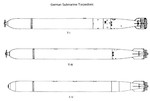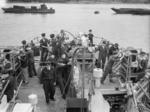G7es Type V Torpedo
| Country of Origin | Germany |
| Type | Torpedo |
| Diameter | 534.500 mm |
| Length | 7.163 m |
| Weight | 1495.000 kg |
| Range | 5.700 km |
| Machinery | Electric Motor - Acoustic Homing |
| Explosive Charge | 200 kg Hexanite |
| Speed | 33.00 km/h |
Contributor: David Stubblebine
ww2dbaseGerman submarine warfare in World War II depended on several torpedo models. The G7e types were a series of electrically powered torpedoes that left almost no wake and the G7es Type IV, Falke (Falcon), was the first practical submarine-fired acoustically guided torpedo. The Falke was meant to target merchant ships so its slower speed was not an impediment. Although successful, the service life of the Falke was brief with the advent of the improved and faster G7es Type V Zaunkönig (Wren), which was intended to home in on a convoy's escort ships. The British cleverly gave the German Navy acoustic torpedo the codename of the "German Navy Acoustic Torpedo" or the GNAT. The Type V Zaunkönig became almost universally known as the GNAT, even in many post-war German sources.The GNAT had a passive acoustic homing system comprised of two hydrophone receivers tuned to approximately 24.5 kilohertz, roughly the same frequency as the propellor cavitation from an escort traveling at 10 to 18 knots. Fitted with a magnetic exploder in addition to a contact exploder, the GNAT would regularly explode beneath the screws of an escort ship and not uncommonly blow the ship's stern section completely off.
The GNAT was the same standardized size as all German submarine torpedoes and its electric motors were powered by lead-acid batteries. The GNAT could be fired while surfaced or from depths up to 30 meters. The torpedoes ran straight for the first 400 meters before the acoustic system took over, which was intended as a safeguard for the submarine that launched them. Nevertheless, standing orders after firing a GNAT were to dive to 60 meters and stop engines. There is considerable speculation that submarine U-972 may have been lost to her own Zaunkönig torpedo.
GNAT torpedoes were first delivered on 1 Aug 1943 but saw their first wide-scale deployment in mid Sep 1943 with the 21 submarines of Wolfpack Leuthen. The GNAT saw many successes early on but their arrival was not a surprise to the Allies. Japan was very interested in what the German Navy was doing and also what the Kriegsmarine knew about Allied naval tactics. To that end, the Japanese naval attaché in Berlin, Captain Tadao Yokoi, was feeding a steady stream of detailed information to Tokyo through Purple coded messages. These messages were intercepted and read by Allied codebreakers as fast as Yokoi could send them. The Allies knew all about the GNAT before it ever arrived.
However, Captain Yokoi did not learn about Germany's acoustic torpedo because the Germans shared the information with him. The Germans' intent was to keep this weapon secret from everyone, including and especially the Japanese. The reason Captain Yokoi knew as much as he did was due solely to his own resourcefulness. Even as Germany's area of influence was shrinking, the Germans made great efforts to keep the details of this weapon a complete secret. In the middle of 1944 when the Germans were evacuating their submarine bases in France, for example, the highest priority was given to the removal of all acoustic torpedoes and their testing facilities. This level of secrecy has a lot to do with why there are so few wartime photos of the Zaunkönig.
The arrival of the GNAT in the Atlantic closely followed the introduction of the American aircraft-launched Mark 24 FIDO homing torpedo. FIDO was developed by Vannevar Bush's Office of Scientific Research and Development (OSRD) and, as they had done with the proximity fuze, when OSRD developed the weapon, they also developed its countermeasure. The obvious choice for a countermeasure to a weapon that uses sound to seek its target was to create a harmless sound as a decoy. Allied ships were given special noisemakers to stream behind them, first the British Foxer and then the improved Canadian CAT system. Both systems sometimes interfered with the ships' sonar but with some adjustments, that was worked out.
The GNAT torpedoes had a fairly dramatic initial success but that tapered quickly with the introduction of the Allied countermeasures. Even so, over 700 Zaunkönig torpedoes were fired in combat that resulted in the loss of 77 ships.
Sources:
United States Navy
UBoat.net
U-Boat Archive
Naval Weapons of the World (navweaps.com)
United States National Security Agency Battle of the Atlantic Report
Legion – Canada's Military History Magazine (16 Jun 2017, Sharon Adams)
History.net
Wikipedia ww2dbase
Last Major Revision: Nov 2021
G7es Type V Torpedo Interactive Map
Photographs
 |  |  |
G7es Type V Timeline
| 31 Oct 1943 | The Hallfried, a Norwegian freighter of 2,968 tons, owned by P. Kleppe of Oslo was on route to Ardrossan in southwestern Scotland, United Kingdom with the combined convoys MKS-28/SL-138. The German submarine U-262 (Kapitänleutnant Rudolf Heinz Franke) fired 4 torpedoes (2 FAT and 2 T-3 types) then fired a GNAT torpedo at a destroyer that was acting as esc1943-10-31 The Hallfried, a Norwegian freighter of 2,968 tons, owned by P. Kleppe of Oslo was on route to Ardrossan in southwestern Scotland, United Kingdom with the combined convoys MKS-28/SL-138. The German submarine U-262 (Kapitänleutnant Rudolf Heinz Franke) fired 4 torpedoes (2 FAT and 2 T-3 types) then fired a GNAT torpedo at a destroyer that was acting as escort. Franke reported four detonations but only the Hallfried had been hit. Two of them struck her on the port side, first just forward of the bridge followed by the second at the engine room which caused the vessel to sink immediately. Only three of the crew managed to get away and were picked up after 45 minutes by the British destroyer HMS Wrestler (D35) 2 of the survivors in the water had lifevests on, but the third, who had been asleep when the attack occurred did not (in the same cabin there had also been 2 stokers and 1 of the British messboys, who all made it up on deck). They were pulled under by the suction as were the rest of the crew who were on deck. The English Able Seaman Thomas Shaw was able to get onto a raft that had floated free, while the other 2 were too far away to reach it. It was not unusual for British lads to join Norwegian ships and the Hallfried had 8 British in her crew, the eldest 22, the others just 17 years of age.46.01,-20.45ort. Franke reported four detonations but only the Hallfried had been hit. Two of them struck her on the port side, first just forward of the bridge followed by the second at the engine room which caused the vessel to sink immediately. Only three of the crew managed to get away and were picked up after 45 minutes by the British destroyer HMS Wrestler (D35) 2 of the survivors in the water had lifevests on, but the third, who had been asleep when the attack occurred did not (in the same cabin there had also been 2 stokers and 1 of the British messboys, who all made it up on deck). They were pulled under by the suction as were the rest of the crew who were on deck. The English Able Seaman Thomas Shaw was able to get onto a raft that had floated free, while the other 2 were too far away to reach it. It was not unusual for British lads to join Norwegian ships and the Hallfried had 8 British in her crew, the eldest 22, the others just 17 years of age. |
| 24 Dec 1943 | While escort carrier USS Card and her escorts were shadowing an Allied convoy bound for Gibraltar from Liverpool through bad weather, one of the convoy’s escorts, destroyer HMS Hurricane, was struck by a German GNAT acoustic homing torpedo launched from submarine U-415. 30-feet of Hurricane’s stern was blown off and the ship was scuttled by torpedo the following day. Three were killed and nine were wounded. Card and her screen continued to battle the wolfpack of German U-boats. Destroyer USS Schenck sank German submarine U-645. USS Leary was torpedoed and sunk by U-275, also with a GNAT. 97 of Leary’s crew were killed and 59 were picked up by Schenk. |
| 24 Apr 1945 | One of the ships in USS Bogue’s mid-Atlantic scouting line of destroyer escorts, USS Frederick C. Davis, was torpedoed and sunk by German submarine U-546 with a GNAT acoustic torpedo. 126 men were lost and 66 were rescued. Surrounded by destroyer escorts, U-546 was attacked, forced to the surface, and sunk by gunfire. 26 were lost and 33 were rescued, including the submarine's commander Kapitänleutnant Paul Just. |
Did you enjoy this article or find this article helpful? If so, please consider supporting us on Patreon. Even $1 per month will go a long way! Thank you. Share this article with your friends: Stay updated with WW2DB: |
Search WW2DB
More on G7es Type V
Notable Event:» Conclusion of the Battle of the Atlantic
Current Site Statistics
- » 1,150 biographies
- » 337 events
- » 43,917 timeline entries
- » 1,241 ships
- » 350 aircraft models
- » 207 vehicle models
- » 373 weapon models
- » 123 historical documents
- » 260 facilities
- » 470 book reviews
- » 28,536 photos
- » 432 maps
Famous WW2 Quote
"Among the men who fought on Iwo Jima, uncommon valor was a common virtue."Fleet Admiral Chester W. Nimitz, 16 Mar 1945
Support Us
Please consider supporting us on Patreon. Even $1 a month will go a long way. Thank you!
Or, please support us by purchasing some WW2DB merchandise at TeeSpring, Thank you!